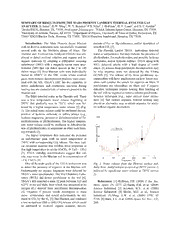
NASA Technical Reports Server (NTRS) 20090022803: Summary of Results from the Mars Phoenix Lander's Thermal Evolved Gas Analyzer PDF
Preview NASA Technical Reports Server (NTRS) 20090022803: Summary of Results from the Mars Phoenix Lander's Thermal Evolved Gas Analyzer
SUMMARY OF RESULTS FROM THE MARS PHOENIX LANDER’S THERMAL EVOLVED GAS ANALYZER. B. Sutter1, D.W. Ming2, W. V. Boynton3 P B. Niles2, J. Hoffman4, H. V. Lauer5, and D. C. Golden6 1Jacobs/ESCG, Houston TX, 77058, [email protected]. 2NASA Johnson Space Center, Houston, TX 77058. 3University of Arizona, Tucson, AZ 85721 4 Department of Physics, University of Texas at Dallas, Richardson, TX 75083 5ESCG/Barrios Tech., Houston, TX 77058. 6ESCG/Hamilton Sundstrand, Houston, TX 77058. Introduction: The Mars Phoenix Scout Mission posiotn of Fe- or Mg-carbonates, and/or desorption of with its diverse instrument suite successfully examined adsorbed CO [3]. 2 several soils on the Northern plains of Mars. The The Phoenix Lander TEGA instrument detected Thermal and Evolved Gas Analyzer (TEGA) was em- water at temperatures that may indicate the presence of ployed to detect evolved volatiles and organic and in- phyllosilictes, Fe-oxyhydroxides, and possibly hydrous organic materials by coupling a differential scanning carbonates, and/or hydrous sulfates. TEGA along with calorimeter (DSC) with a magnetic-sector mass spec- WCL detected calcite with a high degree of confi- trometer (MS) that can detect masses in the 2 to 140 dence. O release from perchlorate decomposition may 2 dalton range [1]. Five Martian soils were individually be why organics were not detected by the Viking heated to 1000°C in the DSC ovens where evolved GC/MS [5]. The release of O from perchlorate de- 2 gases from mineral decompostion products were exam- composition will have implications on how future mis- ined with the MS. TEGA’s DSC has the capability to stions will conduct the search for organics on Mars. If detect endothermic and exothermic reactions during perchlorates are ubiquidous on Mars and if organic heating that are characteristic of minerals present in the detection techniques require heating then leaching of Martian soil. the soil will be required to remove soluble perchlorate. The EGA detected water in the Phoenix soil. There Solution techniques (e.g., super critical water extrac- was a low temperature water release beginning at tion) [6] that extract organics without heating may 295°C that gradually rose to 735°C which was fol- provid an alternative way to obtain organics for analy- lowed by a higher temperature water release [2] (Fig. sis without organic destruction. 1). The initial water release could be attributed decom- position of hydrous carbonate or sulfate phases (e.g., hydrous magnesite, jarosite) or dehydroxylation of Fe- 1500 oxyhydroxides or phyllosilicates. The higher tempera- ture water release could be attributed to dehydroxyla- ) tion of phyllosilicates or serpentine or other rock form- -1nts s1000 Mass 18 2 ing minerals [2]. ou The higher temperture data indicated the presence e (c Rat500 1 an endothermic peak with an onset temperature at ak e 730°C with corresponding CO release. The most logi- P 2 cal candidate material that exhibits these properties at 0 this high temperature is calcite (CaCO CaO + CO ) 3 2 [3]. TEGA enthalpy determinations suggest that cal- cite, may occur in the Martian soil in concentrations of 0 200 400 600 800 1000 ~3 to 5 wt.% [3] Temperature (oC) One of the main goals of the TEGA instrument was Fig. 1. Water release from the Phoenix surface soil, to detect the presence of organics in the Martian soil. Baby Bear. Initial release occurred at 295°C (arrow 1) Unfortunately no organic fragments were detected by followed by significant water release at 735°C (arrow TEGA’s mass spectrometer. The Wet Chemistry Labo- 2). ratory (WCL) did detect perchlorate in the soil [4]. TEGA’s MS detected a mass 32 peak between 325 and References: [1] Hoffman, J.H. (2008) J. Am. Soc. 625°C in the soil Baby Bear which was presumed to be Mass. Spect. 19, 1377. [2] Smith, P.H. et al. (2009) oxygen (O ) derived from perchlorate decomposition Science Submitted. [3] Boynton, W.V. et al. (2009) 2 [4]. Organics if present would decompose at these Science Submitted. [4] Hecht, M.H. et al., Science same temperatues and would unfortunately be oxi- Submitted. [5] Ming, D.W. et al. (2009) LPSC XL dized to CO by the O [5] The Phoenix soil exhibited #224. [6] Bada, J. L. et al. (2008) Space Sci. Rev., 135, 2 2 a low temperture (200 to 600) CO release which could 269. 2 be attributed to oxidized organic material, decom-
